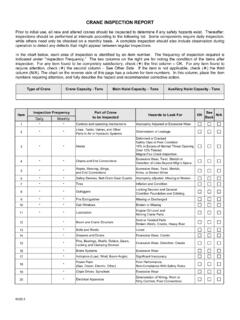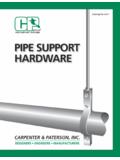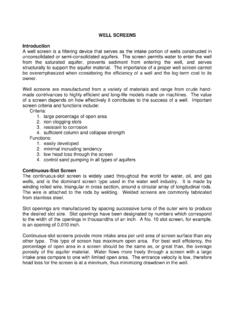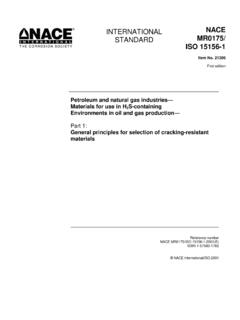Transcription of Safety and Health guide | Welding Health and Safety
1 Welding Health and Safety SS-832 March 2015 Welding Health and Safety SS-832 | March 2015 Page | 2 Table of Contents Introduction ..3 What is Welding ..3 Welding and cutting processes ..3 Types of electrodes ..5 Health hazards ..5 Hazard controls ..10 Special Welding situations ..12 Oxy-fuel gas Welding and cutting ..12 Arc Welding and cutting ..15 Resistance Welding ..16 Appendix A: definitions ..17 Appendix B: common metals and compounds ..18 Appendix C: common Welding gases ..20 Resources ..20 Bibliography ..21 Welding Health and Safety SS-832 | March 2015 Page | 3 Introduction This guide was written to provide a general understanding of the different Welding and cutting processes, the potential Health hazards associated with Welding and cutting, and a summary of the Oregon Occupational Safety and Health Division (Oregon OSHA) regulations, OAR 437 Division 2 Subdivision Q: Welding , Cutting and Brazing (.)
2 257). What is Welding The Welding process joins metals together using pressure, heat, flame or electric arc. In the Welding process, a filler metal, and the work piece are heated to form the weld using an electric arc or combustion gas. Welding and cutting processes There are more than 80 processes used in Welding and cutting. Arc Welding is the process in which fusion is produced by heating with an electric arc that is generated between an electrode and the surface of the base metal. Arc cutting is the general process in which the cutting or removal of metals is done by melting with the heat of an arc between an electrode and base metal.
3 The more common processes are listed below: American Welding Society nomenclature Other names Shielded Metal Arc Welding (SMAW) Stick rod, stick, coated electrode, manual Gas Metal Arc Welding (GMAW) Short arc, MIG (metal inert gas), shielded Welding , hard wire Gas Tungsten Arc Welding (GTAW) Heli-arc, TIG (tungsten inert gas) Flux-core Arc Welding (FCAW) Semi-Automatic Submerged Arc Welding (SAW) Sub Arc, Automatic Welding Plasma Arc Cutting (PAC) Plasma cutting Plasma Arc Welding (PAW) Plasma Welding Carbon Arc Cutting (CAC)
4 Arc Gouging, Air-arcing Oxy-acetylene Welding or Cutting Torch Welding or cutting, gas Welding or cutting Shielded metal arc Welding (SMAW) (also known as stick Welding ) is an arc Welding process which produces coalescence by heating with an electric arc between a covered metal electrode and the surface of the base metal. Shielding is obtained from decomposition of the electrode covering. Filler metal is obtained from the electrode. The consumable electrodes usually consist of a low-carbon steel core with a coating of slag-making and gas-making agents and may include alloying and deoxidizing agents as well.
5 Welding Health and Safety SS-832 | March 2015 Page | 4 Gas metal arc Welding (GMAW) or MIG (metal inert gas) Welding is an arc Welding process wherein coalescence is produced by heating with an arc between a continuous filler metal electrode (typically a steel alloy wire ) and the work. Shielding is obtained entirely from an externally supplied gas mixture. There are four major types of gas metal arc Welding depending on the shielding gas or type of metal transfer that is used. They include: 1. Micro- wire using short circuiting transfer and allowing all position Welding 2. Carbon dioxide using shielding gas of carbon dioxide and larger electrode wire 3.
6 Metal inert gas (MIG) using pure inert gas shielding on non-ferrous metals 4. Spray using argon/oxygen shielding gas Gas tungsten arc Welding (GTAW) or TIG (tungsten-inert gas) Welding is an arc Welding process wherein coalescence is produced by heating with an arc between a single tungsten electrode and the work. Shielding is obtained from an inert gas or an inert gas mixture. Filler metal may or may not be used. The outstanding features of GTAW Welding are that it will make top quality welds in almost all metals and alloys used in industry and practically no post weld cleaning is required. The arc and weld pool are clearly visible to the welder, there is no filler metal across the arc stream, so there is no weld spatter.
7 Welding is possible in all positions, and there is no slag produced which might be trapped in the weld. Flux cored arc Welding (FCAW) is an arc Welding process where coalescence is produced by heating with an arc between a continuous filler metal electrode and the work. Shielding is obtained from a flux contained within the electrode. Additional shielding may or may not be obtained from an externally supplied gas or gas mixture. The process may be either semiautomatic, the most widely used, or automatic. Submerged arc Welding (SAW) is an arc Welding process which produces coalescence by heating with an arc or arcs between a bare metal electrode or electrodes and the work.
8 The arc is shielded by a blanket of granular, fusible material on the work. Pressure is not used and filler metal is obtained from the electrode and sometimes from a supplementary Welding rod. The process may be either automatic or semiautomatic, with the automatic method being most widely used. The outstanding features of the submerged arc process are high Welding speed, high metal deposition rates, deep penetration, smooth weld appearance, good x-ray quality welds, easily removed slag covering, and the ability to join a wide range of material thicknesses Plasma arc cutting is the process in which the metal is cut by melting a localized area with a constricted arc and removing the molten material with a high velocity jet of hot, ionized gas.
9 Plasma arc Welding is an arc Welding process similar to gas tungsten arc Welding (GTAW). The electric arc is formed between an electrode (which is usually but not always made of sintered tungsten) and the work piece. The key difference from GTAW is that in PAW, by positioning the electrode within the body of the torch, the plasma arc can be separated from the shielding gas envelope. The plasma is then forced through a fine-bore copper nozzle which constricts the arc and the plasma exits the orifice at high velocities (approaching the speed of sound) and a temperature approaching 20,000 C. Plasma arc Welding is an advancement over the GTAW process.
10 This process uses a non-consumable tungsten electrode and an arc constricted through a fine-bore copper nozzle. PAW can be used to join all metals that are weldable with GTAW ( , most commercial metals and alloys). Welding Health and Safety SS-832 | March 2015 Page | 5 Carbon arc cutting arc gouging is an arc cutting process in which metals to be cut are melted by the heat of a carbon arc. The molten metal is removed by a blast of air. This is a method for cutting or removing metal by melting it with an electric arc and then blowing away the molten metal with a high velocity jet of compressed air. The air jet is external to the consumable carbon-graphite electrode.














